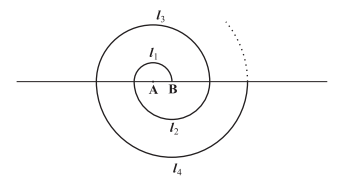10th Grade > Mathematics
ARITHMETIC PROGRESSIONS MCQs
:
A
(i) 7,13,19....,205
First term, a=7
Common difference, d=13−7=6
an=205
Using formula an=a+(n−1)d to find nth term of arithmetic progression, we get
205=7+(n−1)6
⇒205=6n+1
⇒204=6n
⇒n=2046=34
Therefore, there are 34 terms in the given arithmetic progression.
(ii) 18,312,13,...−47
First term, a=18
Common difference, d=312−18=−52
an = − 47
Using formula an=a+(n−1)d to find nth term of arithmetic progression, we get
−47=18+(n−1)(−52)
⇒−94=36−5n+5
⇒5n=135
⇒n=1355=27
Therefore, there are 27 terms in the given arithmetic progression.
:
Here, First term, a=3
Common difference, d=8−3=5
an=78
Using formula an=a+(n−1)d to find nth term of arithmetic progression, we get
an=3+(n−1)5 {we want to find value of n here.}
⇒78=3+(n−1)5
⇒75=5n−5
⇒80=5n
⇒n=805=16
It means 16th term of the given AP is equal to 78.
:
Length of semi-circle =circumference of circle2 = 2πr2 = πr .
Length of semi-circle of radii 0.5 cm = π×0.5 cm
Length of semi-circle of radii 1.0 cm = π×1.0 cm
Length of semi-circle of radii 1.5 cm = π×1.5 cm
Length of semi-circle of radii 2.0 cm = π×2.0 cm
.....and so on
π(0.5),π(1.0),π(1.5)..... 13 term (There are total of thirteen semi-circles}.
For total length of the spiral, we need to find sum of the sequence 13 terms
Total length of spiral = 0.5π+π+1.5π+2π........upto 13 terms
⇒ Total length of spiral = π(0.5+1.0+1.5+.......) upto 13 terms
Sequence 0.5, 1.0, 1.5 ....13 terms is an arithmetic progression.
Let's find the sum of this sequence.
a=0.5;d=0.5
S=n2(2a+(n−1)d)
⇒S=132(2×0.5+(13−1)(0.5))
⇒S=132(1+6)
⇒S=912=45.5
So
⇒ Total length of spiral = π(0.5+1.0+1.5+.......)
⇒ Total length of spiral = π(45.5)=143 cm
:
A
The given sequence is 5, 2, -1, -4, -7, ...., an AP with first term a=5 and common difference d=2−5=−3.
The sum to n terms of an AP of first term a and common difference d is
Sn=n2[2a+(n−1)d].⇒Sn=n2[10+(n−1)(−3)]
=n2[10−3n+3]
=n2[13−3n]
:
D
As an=3+2n,
so,
a1=3+2×1=5
a2=3+2×2=7
a3=3+2×3=9
List of numbers becomes 5, 7, 9, 11 . . .
Here, 7–5=9–7=11–9=2 and so on.
So, it forms an AP with common difference d=2.
To find S24, we have n=24, a=5, d=2.
Therefore, S24=242(2(5)+(24−1)2)
=12(10+46)=672
:
D
let first term be a and common difference be d
so pthterm=a+(p−1)d
and sum of first p terms=p2(2a+(p−1)d)=q
hence(2a+(p−1)d)=2qp....(1)and qthterm=a+(q−1)d
and sum of first q terms=q2(2a+(q−1)d)=phence(2a+(q−1)d)=2pq....(2)subtract (1) from (2)(p−q)d=2(qp−pq)=2(q2−p2)qso,d=−2(p+q)pq....(3)(p+q)thterm=(a+(p+q−1)d)and sum of its first(p+q)term=(p+q)2(2a+(p+q−1)d)=(p+q)2(2a+(p−1)d+qd)=(2qp+qd)(p+q)2...from(1)=(2qp−2−2qp)p+q2...from(3)=−(p+q)
:
B
The arithmetic mean of two numbers is the simple average of the two numbers.
Thus,
AM=Sum of the numbersNumber of numbers
=a+b2
:
C
Given, x+1,3x,4x+2 are in AP.
So, the difference of any two consecutive terms will be the same.
∴3x–(x+1)=(4x+2)–3x
⇒ 2x−1=x+2
⇒ x=3
So, the first term of the AP is a=x+1=3+1=4.
The second term of the AP is 3x=3×3=9.
∴Common difference, d=9–4=5
The nth term of an AP with first term a and common difference d is given by
tn=a+(n−1)d.
⇒t5=4+4(5)=24
:
B
Given that
a11=38 and a16=73,
where a11 is the 11th term and a16 is the 16th term of an AP.
The nth term of an AP with first term a and common difference d is given by
an=a+(n−1)d.
⇒38=a+10d ....(i)
73=a+15d ....(ii)
Subtracting equation (i) from equation (ii), we get
35=5d.
⇒d=7
Substituting the value of d in equation (i), we get
a=38−10d=38−10(7)=−32.
Now, a31=a+(31−1)d =−32+30(7)
=178
Therefore, the 31st term of the given AP is 178.
:
A
Given, a3=4 and a9=−8, where a3 and a9 are the third and ninth terms of an AP respectively.
Using the formula for nth term of an AP with first term a and common difference d,
an=a+(n−1)d, we get
a3=a+(3−1)d and a9 = a+(9−1)d.
⇒4 = a+2d...(i)
−8= a+8d...(ii)
Substituting the value of a from equation (i) in equation (ii), we have
−8=4−2d+8d
⇒−12 = 6d
⇒ d =−126 =−2
Solving for a, we get −8 = a−16.
⇒a = 8
Therefore, the first term of the AP is 8 and common difference is −2.
Let the nth term of the AP be zero.
i.e., an=0
a+(n−1)d=0
8+(n−1)(−2)=0
⇒ 8−2n+2=0
⇒ 2n=10
⇒ n=102=5
Therefore, the 5th term of the AP is equal to 0.

















